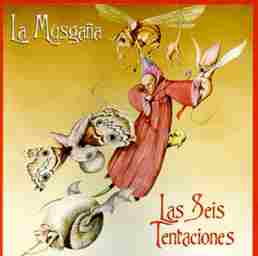The Free-Reed Review
Critiques of Compact Discs, Books and Music
Scores
CD Review:
La Musgana
Las Seis Tentaciones

Enrique Almendros: gaita charra y tamboril (3-holed flute & tabor), gaita de floe (bagpipes), pandero cuadrado (square drum)
Carlos Beceiro: bajo (bass), viola Braguesa (guitar), cistro (cittern)
Jaime Munoz: clarinete (clarinets), flauta (flutes), acordeon (accordion), kaval (Bulgarian flute)
Luis Delgado: D'rbuka (Arabian goblet-shaped drum), pandera (tambourine), pandereta (small tambourine), bendhir (large Moroccan tambourine), cantaras (drum made from a pitcher), santur (hammered dulcimer), laud (Arabic lute), tecias (keyboards)
Kepa Junkera: Trikitixa (diatonic Basque accordion)
Program:
Charro Zamorano
El Mirlo
Salamanca La Blanca
Mudanza del Rio
Sal a bailar, mocita
El rondador desesperado
Jotas de Gaita
Pasacalles "El alba"
Aire Religioso
Pica de bodas
Seguidillas Madrilenas
Toque de Teatro
Charro Salmantino a Trio
Total Time: 48:25
Released in 1995
Label: Green Linnet Records
43 Beaver Brook Road
Danbury, CT 06810 USA
telephone: 800-468-6644
Review by
Henry Doktorski:
The first thing I noticed about the CD "Las Seis Tentaciones" by La
Musgana was the cover: a surreal painting (appearing to me to be
stylistically somewhere between Salvador Dali and Albrecht Durer) by
multi-talented Enrique Almendros, who also performs on flute, bagpipes &
drum on the album. The painting depicts Saint Antonio being attacked by
worldly temptations in the form of monsters, hence the title: "Las Seis
Tentaciones."
The second thing I noticed was the music: an enchanting celebration of
indigenous Spanish music - merged with Gypsy, Moorish and Celtic
influences - performed on an exotic combination of traditional and modern
instruments. All pieces except for one (El Mirlo) are traditional (and
most of the instruments played are also traditional) but the overall sound
is decidedly contemporary, partly due to the artistry of Carlos Beceiro on
electric bass and Luis Delgado on synthesizer / keyboards.
"Salamanca La Blanca," with it's ethereal hammered dulcimer minor-modal
melody and deep pulsating synthesizer drone deserves to be broadcast on
"Hearts of Space," or any other quality NPR new-age radio show. "Aire
Religioso" comes from a similarly inspired meditative space, with it's
ecstatic bagpipe melody accompanied by sustained electric bass chords.
The other tracks are dance numbers, with the percussion instruments
playing prominent parts. Dances include the charro, fandango, charrada,
mudanza, pica, seguidilla, waltzes and charro salmantino.
Although the accordion is not a regular solo instrument in the ensemble,
it is, never-the-less, featured prominently in the acordeon / trikitixa
(diatonic Basque accordion) duet which begins track 12. The acordeon
(played by Jaime Munoz) appears only once on the album ( in track 12), but
the trikitixa (played by guest artist Kepa Junker) appears in three other
tracks: 2, 10 and 11.
I found "Las Seis Tentraciones" to be a truly pleasing and delightful
listening experience and I think you will also.
